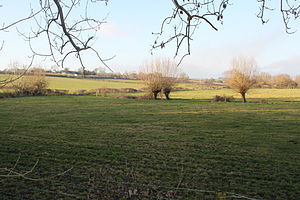Battle of Langport
| Battle of Langport | |||||||
|---|---|---|---|---|---|---|---|
| Part of English Civil War | |||||||
 The site of the battle |
|||||||
|
|||||||
| Belligerents | |||||||
| Parliamentarians | Royalists | ||||||
| Commanders and leaders | |||||||
| Sir Thomas Fairfax | George, Lord Goring | ||||||
| Strength | |||||||
| 10,000 | 7,000 | ||||||
| Casualties and losses | |||||||
| unknown | 300 killed 500 captured |
||||||
The Battle of Langport was a Parliamentarian victory late in the First English Civil War which destroyed the last Royalist field army and gave Parliament control of the West of England, which had hitherto been a major source of manpower, raw materials and imports for the Royalists. The battle took place on 10 July 1645 near the small town of Langport, which lies south of Bristol.
Taunton had been captured by the Parliamentarian army under the Earl of Essex in June 1644. After Essex's army was forced to surrender at Lostwithiel in Cornwall in September, the Royalists maintained a siege of Taunton, although the town was briefly relieved by Sir William Waller in late November.
When determining strategy for 1645, King Charles I had despatched George, Lord Goring, the Lieutenant General of Horse (cavalry), to the West Country with orders to retake Taunton and other Parliamentarian outposts in the area. Although Goring briefly rejoined the King's main 'Oxford Army', tensions between him and Prince Rupert, the King's Captain General and chief adviser, resulted in Goring's force returning to the west.
Parliament had meanwhile sent a substantial detachment commanded by Colonel Ralph Weldon, consisting of one cavalry regiment and four infantry regiments from their New Model Army, to relieve Taunton. They raised the siege on 11 May 1645, but were themselves besieged by Goring's returning army (although there was no longer any danger of the Royalists storming the town).
On 14 June 1645, the main body of the New Model Army under Sir Thomas Fairfax, with Oliver Cromwell as Lieutenant General of Horse, won the decisive Battle of Naseby, destroying Charles's main army. After the Royalist garrison of Leicester surrendered four days later, the New Model Army was free to march to the relief of Taunton.
...
Wikipedia
